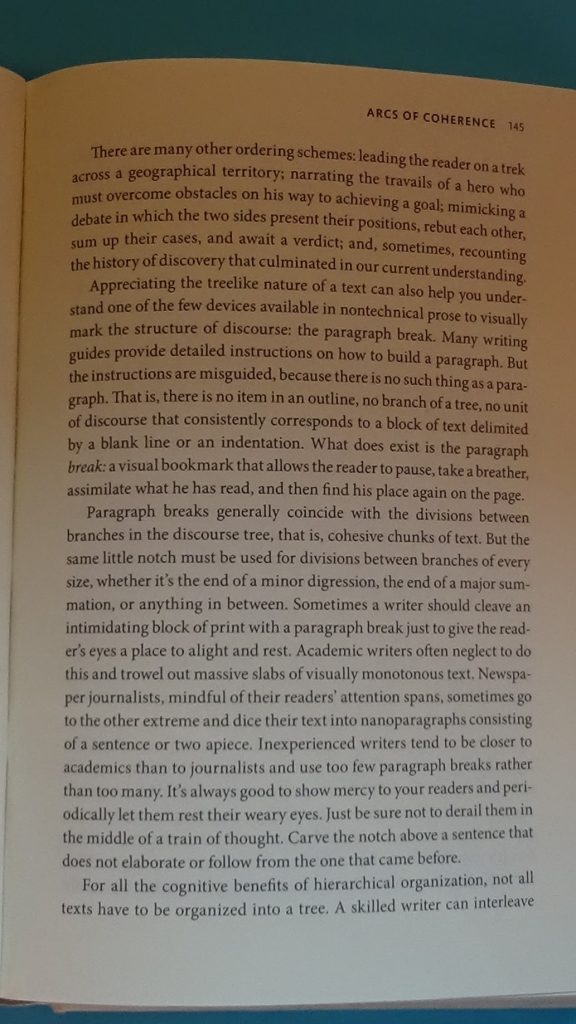In response to my last post, Julia Molinari drew attention to a rather radical critique of my position by Steven Pinker. In The Sense of Style, Pinker writes as follows:
Appreciating the treelike nature of a text can also help you understand one of the few devices available in nontechnical prose to visually mark the structure of discourse: the paragraph break. Many writing guides provide detailed instructions on how to write a paragraph. But the instructions are misguided, because there is no such thing as a paragraph. That is, there is no item in an outline, no branch in a tree, no unit of discourse that consistently corresponds to a block of text delimitated by a blank line or an indentation. What does exist is the paragraph break: a visual bookmark that allows the reader to pause, to take a breather, assimilate what he has heard, and then find his place again on the page. (145)
It’s hard to imagine a stronger criticism of something than “there is no such thing”. The irony, which Pinker is wholly aware of, of course, is that what I have just quoted is itself a paragraph. Its key sentence is “The paragraph break visually marks the structure of discourse,” and it undertakes to help the reader understand this idea–it elaborates on it, explains it. Along the way, then, it finds itself saying that it does not (in a particular sense) exist, that there is no such thing as the paragraph it is trying to be. There is only the “visual bookmark” between what comes before and what comes after. It looks like this on the page:
When Pinker says that paragraphs don’t exist, he obviously means this in some formal, linguistic sense. (He’s a linguist, after all.) As Iain McGee puts it: “There is no necessary linguistic reason for a text to be segmented into paragraphs” (239, emphasis in the original). But while Pinker tells us that paragraph breaks offers readers a place to rest, McGee points out that “the paragraph aids the writer in constructing the text” (ibid.) Indeed, I suggest that writers construct paragraphs as much to be kind to themselves as to be kind to their readers. But what McGee and Pinker seem to agree about here is that the paragraph has no intrinsic motivation, no individual dignity, no essence.* And this is the idea I want to challenge.
Essences need not be timeless. To say that something is constructed is not to say that it isn’t real; Foucault famously proposed that there is a “historical a priori“. What this really means is that intelligence has a tradition and this tradition has consequences, in part for how we use language. But the history of discourse is manifest not just as a constraint on what we can say, or a demand on how we say it; our present day discursive conditions are, much more importantly, affordances. (Julia and I have talked about this before.) They allow us to say to say things more effectively and more efficiently than we otherwise could. The traditional paragraph, I want to argue, is such an affordance.
The utility of the paragraph is not just that it breaks up the page, giving the reader and the writer a rest (a break). It’s not a merely visual effect. I’m a pretty staunch defender of the paragraph as a coherent “unit of discourse” that we can make (or, as Pinker puts it, build) well or not so well. Crucially, I believe that we can learn to become better at making such things, not just carving our stream of consciousness into the appearance of them. A paragraph, in the sense that I use that word, is not just whatever happens between a set of visual markers (like a tab indent and a line return). As I said on Twitter, it is a what Deleuze and Guattari call a plateau — “a self-vibrating region of intensities”.
I realize that invoking Deleuze is not the most familiar rhetorical move in defense of the traditional prose paragraph. But let’s remember that T. S. Eliot, who arguably invented modernist poetry (or was at least given credit for doing so by the Nobel Prize committee) did not see his innovations as a break with tradition, but as a continuation of it.
We know how to write paragraphs. Or we know how to write a great many different kinds of paragraph that achieve a wide variety of effects. These skills can be taught and students who learn them will be better writers, and better thinkers, as a result. A paragraph can’t do everything, and will accomplish nothing automatically simply by following a set of prescriptions. But that does not mean that they don’t have their own, internal reason for being. Nor that they can’t find their own composure.
(to be continued…)
_______________
*Update: This resonates nicely with some Mike Duncan says in his very useful review of the scholarship on the paragraph: “It is the most obvious and visible evidence of the ebb and flow of our thoughts in writing. Hold a typed page ten feet away — the words fade to smudges, but the indented visual structure remains” (472).
